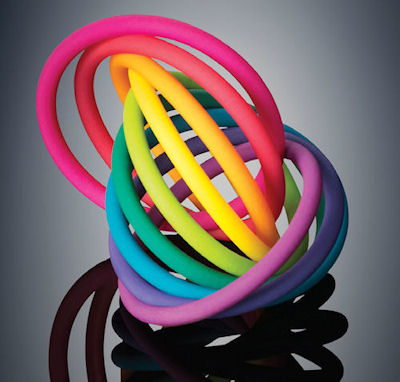Latest News
February 4, 2014
By Anthony J. Lockwood
Dear Desktop Engineering Reader:
Last week at SolidWorks World, Stratasys launched its Objet500 Connex3 Color Multi-Material 3D Printer. Just its full name tells you why this is an interesting device to check out: a 3D printer that combines colors—plural—with multiple materials—plural— to produce parts and assemblies. And it does that in a single run. And that means parts emerge from its 19.3 x 15.4 x 7.9 in. (490 x 390 x 200mm) build envelope looking much like an off-the-shelf part or assembly, and you didn’t have to do any painting or assembly. And all of this means you can save a lot of time playing with ideas, validating designs, wowing clients and what have you.
 |
Today’s Check it Out link takes you to a 5-page PDF that provides a quick look at the Connex3 and the technology that enables it to do what it does. Perhaps more importantly, the paper also provides some real-world tips and tricks on how to leverage the multi-material and multi-color capabilities this 3D printer offers. See, multi-color, multi-material 3D printing is not just printing a colored part. It’s a technology jump that can change the way you think about 3D prototyping and integrate it within your process.
“Objet500 Connex3: How to Maximize Multi-Material and Color Possibilities” starts with an overview of color 3D printing and provides an intro to the Connex3. The intro is paired with a few paragraphs on how an early user, Trek Bicycle Corporation, deployed the Connex3 and the effects it has had on productivity. They spent less time swapping materials simply because the Connex3 uses three materials and can color-code design iterations for at-a-glance identification.
Next, the paper explores the Connex3’s triple-jetting technology. Broadly, what’s going on here is that the technology adds a third PolyJet photopolymer material and three new base colors to your material mix. By the way, the colors—VeroCyan, VeroMagenta and VeroYellow— are new to the PolyJet material line, which already includes digital materials as well as rigid, rubber-like, transparent and high-temperature materials.
So, the Connex3 jets droplets of three base colors and blends them to produce hundreds of colors. Specifically, this presents you with 10 color palettes with each palette offering 45 or 46 hues to work with (an image in the paper depicts these colors). The Connex3 can also mix one or two base colors with a clear material to produce translucent colors, and you can blend two materials to create new combinations. You can also 3D print parts with dissimilar materials.
The upshot is that you get parts that have color throughout, rather than just on the outer surfaces. This process also makes color selections repeatable and consistent during a print run and, if you want, over multiple design iterations. Furthermore, the combination of base materials and colors gives you a lot of opportunity to explore functional prototypes of many different colors and materials. For that matter, you can use the Connex3 to print out a bunch of your FEA (finite element analysis) and CFD (computational fluid dynamics) stress and structural analysis results.
While describing the technology, the paper also imparts the skill. The way that this is done is both fascinating and well executed. The gist of it is that the multi-material and multi-color 3D process has effects on your workflow beyond color and material choices. None of these effects seem arduous, but the knowledge imparted here will shorten your learning curve.
By way of example, just dumping over an STL to Connex3 might get you assemblies that separate where you don’t want them to detach. To avoid this, you need to create a model as a multi-body assembly and export it as separate STLs. The system’s Objet Studio software then interactively calculates individual bodies so that all the materials fit properly.
The paper wraps with some techniques to smooth your transition to multi-material and multi-color 3D printing as well as maximizing your results. The paper has some nice images that give you an idea of the type of things that you can do with the Objet500 Connex3 Color Multi-Material 3D Printer.
All in all, “Objet500 Connex3: How to Maximize Multi-Material and Color Possibilities” is an informative paper about an intriguing new offering from Stratasys. I found myself imagining assemblies that would benefit from a design and validation process that had a multi-material, multi-color 3D printing component. It’s always a good omen when I start doing that. Hit the link and download your complimentary copy.
Thanks, Pal. – Lockwood
Anthony J. Lockwood
Editor at Large, Desktop Engineering
Read: Objet500 Connex3: How to Maximize Multi-Material and Color Possibilities
Subscribe to our FREE magazine, FREE email newsletters or both!
Latest News
About the Author
Anthony J. Lockwood is Digital Engineering’s founding editor. He is now retired. Contact him via [email protected].
Follow DE





